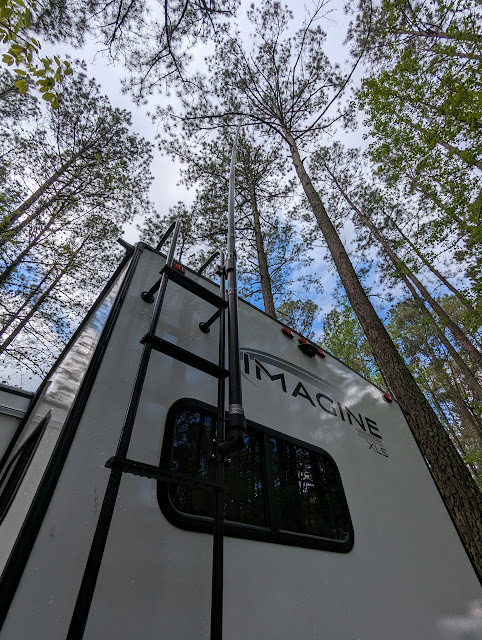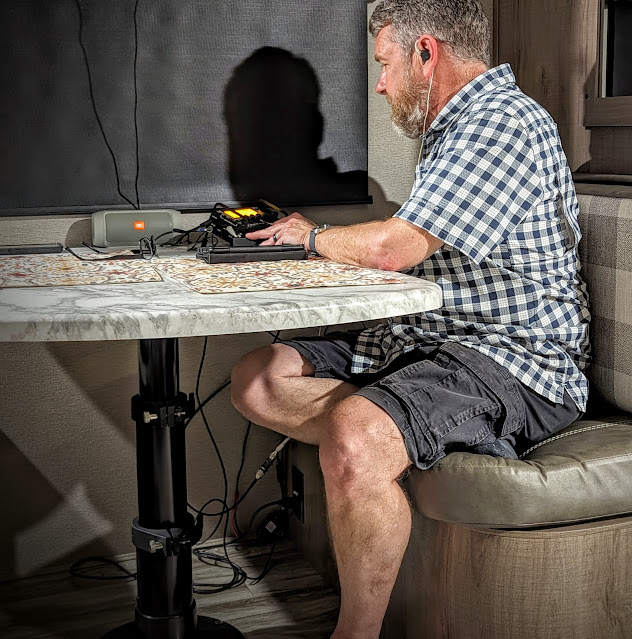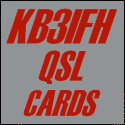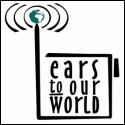Posts Tagged ‘Morse Code’
 The Art of DX Pileup Busting
The Art of DX Pileup Busting
SOME INFORMAL THOUGHTS ON WORKING CW DX
Recently, I came across some questions another amateur radio operator posed to a group of CW enthusiasts. Since I have an interest in Morse code, I thought I would explore these questions:
— begin quote —
1. When chasing some particular CW DX station needed for my DXCC punch-list, what are some things(s) that one can do to improve one’s chances of snagging that DX contact amidst a congested pileup? Is it truly the luck of the draw or roll of the dice? Or are there some time tested methods, less than obvious, that the experienced CW DX chasers have used that seem to improve one’s chances of snagging the DX contact? Yes, I’m aware that there are many variables to consider. I’m just looking for some general suggestions to improve my odds of success based on the experience of others.
2. If, let’s say, a DX station appends “UP 1” or “QSX 2” to his CQ call or just “UP” appears in a DX cluster spot listing, what is considered an acceptable amount of “UP”? I’m amazed sometimes at the amount of “UP” that I hear. LOL. Does a hefty amount of “UP” actually improve one’s chances? What does the DX op expect?
3. After a DX station sends their callsign how long should one wait to reply with one’s callsign? I hear stations respond immediately. But sometimes I hear others wait just a “bit”, and then respond to DX. And sometimes when the DX station is responding to a chosen station, other callers are STILL calling the DX op. What do most DX operators expect with regard to the response of a reply? Immediate? One-Mississippi …?
4. I hear stations reply to DX with their callsign once. Others sometimes twice. If I send my callsign twice I run the risk that the DX station has already begun his reply back to me with my sig-report while I’m still in the midst of sending my 2nd callsign reply. So … I should send my call just once?
— end quote–
Great questions! And, the answers translate over to working DX pileups on voice, too.
Here are some of my off-the-cuff remarks, based on my limited experience DXing since 1990:
(I am an avid DXer, with 8BDXCC, etc.)
1. Listen, Listen, Listen: The DX station typically does work split – the DX station on, say, 14.023 MHz, and the DX station is listening anywhere from 14.028 to 14.033 (up 5 to 10). You first, of course, need to listen to the DX station, but, also to hear the stations that are calling the DX station! The trick is to be able to hear some of the stations that are piling up on the DX, and to determine if the DX is working a station, then tunes up a little, or down a little, from the frequency on which the last caller was chosen.
Once you know this, you want to position your signal so that the DX operator tunes to or very near where you are transmitting your signal. If the DX station does not call you but continues in the same tuning direction, you reposition your transmit frequency (always in the pileup window) and try again. If you do not know where the DX station is listening next, and especially if you cannot HEAR the DX station, you are calling blind and are in for a long effort.
If you have a way to see the waterfall at and around the DX frequency, you can often see the general spread of “UP” where the callers congregate. When listening (and, let me tell you, listening is key) to the DX station, watch the waterfall for the responding caller (the station in the pile-up calling the DX), as sometimes it is very obvious who is answering the DX. Watch this exchange for a number of new callers – and get a sense of HOW the DX operator is moving through the pile-up. Anticipate where the DX might listen next. Choose that “next frequency in the pattern of movement” and use that as your calling frequency.
2. Timing your call: this takes a bit of effort. I typically listen to my chosen transmit frequency, trying to call never at the exact same time as others, on or near my calling frequency.
3. I always send my callsign TWICE… something like this:
DX: DX1ABC UP
ME: NW7US NW7US
DX: NW7US 5NN
ME: R R NW7US 5NN TU
DX: NW7US TU, DX1ABC UP
There are some fine CW-oriented DXing books, PDFs, and websites that talk about this. For instance:
http://sota-dl.bplaced.net/articles/cw_chasing_tips_for_newcomers.pdf
https://www.cadxa.org/getting-started-in-dxing.html
I hope this personal observation of mine about working a Morse code pileup is helpful in some way.
73 de NW7US
https://NW7US.us
..
 Begali Intrepid
Begali Intrepid
The Perfect Bug?
A New Design
- The pendulum hinge is at the rear of the key rather than the middle
- The adjustments are all based on magnets rather than springs
- The dwell for the dits has a real control, rather than using various pieces of foam, string or clips to change dwell time
- The dit contact is a sprung plunger that always remains centered on the contact rather than brushing against it at various angles
- The split lever mechanism operates at the center of the key placing the DAH and DIT contacts much closer to one another than a traditional bug
- There is less mass in the pendulum itself than a Vibroplex Bug
- It has a sprung, nylon wheel damper that doesn't clatter
- It weighs a TON (well about 6 lbs) and feels welded to the desk without having to use non-slip material or using spit to semi glue them in place (yech, yes I use spit to hold my keys to my desk)
Preparing for Use
In Use
Conclusions?
 International Morse Code Day (April 27)
International Morse Code Day (April 27)
Morse Code Day on April 27 (every year) honors one of the inventers of the Morse code, Samuel Morse, who was born on this day in 1791.
Samuel Finley Breese Morse (April 27, 1791 – April 2, 1872) was an American inventor and painter. After having established his reputation as a portrait painter, in his middle age Morse contributed to the invention of a single-wire telegraph system based on European telegraphs. He was a co-developer of Morse code and helped to develop the commercial use of telegraphy.
Alfred Vail developed the dot-dash structure, and Leonard Gale along with Vail was instrumental in developing the mechanical receiving apparatus for code.
Samuel Morse gets most of the credit because of his work in promoting this code as a viable means of communication. Morse code is still used now. Amateur radio is one of the communities in which Morse code is popular and in daily use.
73 de NW7US dit dit
https://NW7US.us
..
 Portable Ops in Comfort
Portable Ops in Comfort
 |
| Working my rolling shack portable station from air-con comfort |
 |
| Early try with a military fiberglass pole mast |
 |
| Now I use a Flagpole Buddy with a 30 foot telescoping mast |
 |
| Gone RF fishing with a 30 foot pole and a big sinker. |
 |
| Palm Radio Single Paddle |
 |
| On the Eagle the Palm Radio Single magnetically attaches to the side |
 |
| Note the power and antenna connections under the table |
 Benefits of the Yaesu XF-130CN 300 Hz Crystal Roofing Filter
Benefits of the Yaesu XF-130CN 300 Hz Crystal Roofing Filter
Do You Need That Filter?
The Yaesu FT-DX10 comes standard with a 500 Hz crystal (xtal) roofing filter, but offers an optional 300 Hz roofing filter. Should you purchase the optional filter?
The 300 Hz roofing filter is twice the size of the 500 Hz filter so it must be twice as good right?
If you casually switch back and forth between the two filters on a noisy band, it sounds like the 300 Hz filter markedly improves selectivity and quiets the noise. But try this: Select the 500 Hz filter and narrow the bandwidth (using the bandwidth control) to 300 Hz, then switch to the 300 Hz filter.
When you digitally narrow the bandwidth of the 500 Hz filter to 300 Hz you will "hear" the same reduction in noise as you have cut out 200 Hz of higher frequency sound. Engaging the 300 Hz filter lowers the volume a bit (3-6 dB) due to insertion loss.
So what you are actually "hearing" when you switch back and forth between the filters without changing the digital bandwidth is the reduction of the higher frequency noise that can be accomplished using the bandwidth control alone with the 500 Hz filter.
So, from a selectivity standpointthe 300Hz filter doesn't gain you anything over using the digital filtering with the 500 Hz filter. The real benefit should come in the form of adjacent signal rejection. So let's look at that.
In the video below I demonstrate the signal rejection of a 40 dB over S9 adjacent signal to a weaker S3 - S5 signal.
From the video you can hear that there is a very small demonstrable difference in strong signal rejection when using the 300 Hz optional filter, but the difference is so small that I doubt many of us would find practical benefit over simply narrowing the DSP bandwidth while using the 500 Hz filter. Even when contesting. The digital filtering built into the FT-DX10 is really, really good when using the included 500 Hz roofing filter alone.
Yes, I spent the $200 for the optional filter thinking it would help, but I wished I had known what I do now. I would have $200 for some other nifty radio gadget to spend instead.
That's all for now.
Lower your power and raise your expectations
Richard AA4OO
 New Book: Learning, Living, and Loving Morse Code…
New Book: Learning, Living, and Loving Morse Code…
There is a new book from a fellow Morse code amateur radio operator, Chris Rutkowski (NW6V), about “Learning, Living, and Loving Morse Code (in a Digital World).” NICE!
Title: “The CW Way of Life“
link: https://amzn.to/3Tm3KfD
Already, I think it rivals any other book on the topic, including “The Art and Skill of…,” or, “The Zen of…”
It is not, however, meant to replace, but to augment, what is available. But, it is a complete guide, including a “work book” section (nearly half of the book?) on how to improve your skill. Really good stuff, but I’m only in one day.
73 de NW7US dit dit
https://nw7us.us
..
 Unexpected Surprise: What Are The Odds? ATNO DXCC
Unexpected Surprise: What Are The Odds? ATNO DXCC
I have a story for you. All of it is true, but I have not changed my name.
Wow! I am always amazed at those moments in my amateur radio hobby when spontaneous joy is had by unexpected events.
On Thursday, 14-April-2022, at about 17:30 Universal Time (UT), the unexpected occurred, and it started by accident.
I have been reorganizing my radio shack. Once I moved my main transceiver (the Icom IC-7610) from one desk to another, and had it back in operation, I left it tuned to a random frequency, in the CW mode. It was just sitting there, hissing away with the typical shortwave sounds of a frequency on which no one was transmitting. And me? I was going about reorganizing my radio shack.
After a while, I heard the start of a Morse-code CW signal; the operator was sending a CQ call–a transmission that invites a response from anyone who wishes to have a QSO with the calling station. What I heard was, “CQ CQ DE EP2ABS EP2ABS…”
NOTE: This transceiver, my Icom IC-7610, is listening with the new antenna—the 254-foot doublet up at 80 feet–that was raised up into the air here at my QTH by a fine crew from Hams in the Air.
I looked up EP2ABS on QRZ dot com, because I did not know from what country/entity the EP2 prefix on callsigns belongs. I was excited to see that EP2 is from Iran!
I started answering his CQ call, “DE NW7US NW7US,” for at least ten minutes; each time he sent his CQ, I answered. Finally, I heard him answering me, “NW7US NW7US DE EP2ABS 5NN…”
I answered back, sending my signal report, “5NN 5NN DE NW7US TU”
Soon after that simple exchange, he confirmed our QSO by posting our QSO to Logbook of the World (LotW).
Thus, by accident–as I had simply left the transceiver tuned to a randomly-selected frequency and stayed on that frequency listening while doing my chores–I heard the Iranian station calling CQ. What are the odds!?!?
This is my first QSO with Iran, another All Time New One (ATNO). How cool!
Note: This is a testimony to the work from the crew that did the fine work of getting this antenna installed. Here is a video presented by Hams on the Air:
73 de NW7US dit dit

































